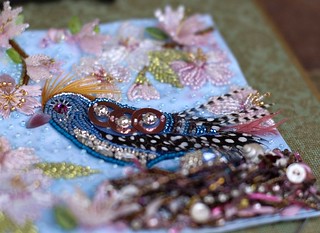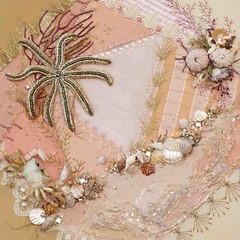[Warning: This post doesn't show a finished product and is written for those interested in the details of my class with Bob Haven. It's a bit technical in nature with lots of pictures. If you're not interested in tambour beading, you may want to skip it...]
OK. Let's get to class. The whole technique of tambour beading revolves around the use of a hook...
You can see from the pic that the needle has quite a snaggly hook to it. This makes it quite tricky to manipulate. It's why you won't see very much "finished" work in this post. Only the beginnings of things.
The word "tambour" means drum in French...that refers to how tight the fabric is stretched across the frame. I loved Bob's method for stretching the fabric using 1"x4" pieces of wood, twill tape and clamps from the hardware store. Very inexpensive and very effective.
I have taken many needlework courses in my life. And most of them have been variations on a theme...almost all using a needle and thread. Even though the technique is new, using a needle and thread is not. Not so with the tambour hook.
In the case of tambour beading, there are some unique characteristics:
- You work with the front side of the work facing down. So, for many stitches...particularly beading and adding sequins, you are working with the backside up and you either have to feel that your stitching is correct or view it through the back of your fabric.
- You work with a hook instead of a needle and the thread is worked from underneath the fabric. You can embroider chain stitches on the fabric, and for this you would flip your work to the front.
- If you are right handed, the right hand stays above the frame and maneuvers the hook. The left hand stays below the frame, manipulating the thread and/or the beads or sequins. This hand sequence is the same in Japanese embroidery so it wasn't completely foreign to me.
Twisting and snapping the thread into the hook, rotating the hook, and then pulling the hook back up to the top.
This is much easier said than done since that little snaggly hook spends most of its time snagging the thread or the fabric when in the hands of an inexperienced user like myself.
Day one, we framed our fabric, traced our design and practiced using the hook. I spent most of the day trying to make chain stitches...just to get used to the movement of the hook in my hand. And this is all I completed...

The next day, we attached gold lame fabric with the hook and then trimmed away the excess. My mind started to wander when thinking about all the possibilities of layering sheer fabrics on top of one another...

We then outlined the gold lame with black bugle beads with the fabric facing down. Since the gold lame blocked my vision, I had to place the bugles by feel. I missed one or two...thinking I had it in place only to find out that they had slipped out of my fat fingers.

Placing the beads around the outside edge of the egg shape and the gold beads around the edges of the flowers was much easier since I could see through the silk organza on which we were stitching.


The only other tool I needed was longer fingernails! I always keep my nails really short and this is one case where having a long thumbnail and pointer fingernail would have made the placing of beads and sequins much much easier.
By the third day, we were beginning to place sequins in a row and learning how to attach them on the flowers. And this is about as far as I got since I left a day early. There were however, many of my classmates who didn't even start on their "egg". They continued to practice trying to get the hang of the hook hour after hour.

We also practiced stippling...

placing beads in random pattern to fill in a larger area. I loved this technique.

Here's an example of Bob's stippling with sequins on his Lesage piece...

and here's a view of what stippling looks like from the back...

Learning this technique reminded me of when I first learned to knit. I had to manipulate new tools (the knitting needles) while trying to figure out how to hold the thread, how to wrap the thread, and then how to move the stitch from one needle to another without dropping a stitch, splitting the yarn or messing up. I remember being very slow and making tons of mistakes. That's what learning to use a tambour hook was like for me. Very very slow going...with only a few rows to show for hours and hours of labor.
By the third day, I was getting more adept and I could see how one could get lots faster after managing to master the hook. A classmate who had taken a class from Bob previously recommended practicing every day...and I intend to do just that.
If you are interested in learning this technique, my advice would be to manage your expectations. Don't expect to sit down and pick it up right away. A little struggle and difficulty is probably the norm.
All in all, I thoroughly enjoyed my time and having such great classmates made it even more so.

We had quite an accomplished group of beaders, quilters, conservationists, patent/trademark/copyright experts, designers and embroiderers in our class which enriched the time we were together.
Next time I'll show you close-ups of an antique Balmain gown from the '50s that Bob shared with us...
To die for!





















30 comments:
I think there are certain people that are perfect to learn this skill. I, however, would not be one of them since I hate PRACTICE!!
I found your post extremely interesting. I have seen pictures of Tambour embroidery and beading, but never seen or knew how it was done. And the back of the work is almost as pretty as the top, or is that bottom, or is it if you are right handed the top is almost as pretty as the bottom...oh well, it could get COMPLICATED!!
xx, Carol
What an amazing opportunity! The time must have flown by.
Wow,wow,wow.Love it all!
I agree, wow! That looks so interesting and fun.
Seems to me that it would be like patting your head and rubbing your tummy at the same time and I was never good at that... Besides I cut off my pointer finger with a trim saw so that would be a huge handicap for Tambour.....Practice tho so you can show us some finished stuff...YGG
Hugs Ger
I've heard about tambour beading, but this is the first time I have come across a good description - thank you!
I've watched the experts at Lesage and Hand&Lock do tambour beading and I was astonished at how quickly they can work given that it is done from the reverse. Thanks for giving so many details from your class. I doubt I'll ever be skilled enough to do it. I cannot wait to see that dress.
What a great opportunity you had. I am so envious of you learning this new skill. The fact it is difficult to do and takes practice is exactly the reason to do it. Why do what everyone else can. With your needlework skills you will make beautiful pieces to showcase this Tambour embroidery.
Debbie
Absolutely amazingly wonderful, Susan! Thanks so much for the view into this incredible world and fine teacher too.
We will want to see a demo in Connecticut, please please please?!
You will do amazing things with this technique, for sure....
This looks like fun! Thanks for sharing your experience.
It definately takes lots of practice. The only trouble is once you master the HOOK the needle is not so much fun. At least for me. I took my first intro class at Lesage 5 years ago and came home and practiced daily. Last year I did level I and this year I did level II and due to volcanic eruption did level III. What Bob is teaching.. vermichelli and layering at Lesage comes at higher levels. You are fortunate to learn from someone that 1. speaks english...
2. Is a good teacher...
Lesage is great don't get me wrong but they can be not so nice!! Love to hate them but I would go back in a minute!!!
Shirlee Fassell
Fascinating to see how this works! When I was hand quilting, my favorite quilt frame to work on was just like the ones you used for this. Hope Jack's leg is healing as expected!
So very interesting!! Thanks!!
Fascinating, Susan. It looks like you've found your summer project, practicing and finishing your beading. So, are you a leftie? In that one photo it looks like you're drawing with your left hand.... Thanks for a step by step look into your week!
Oh, how I wish I could have done this class with you. I think you got a lot done, I'm sure I would not have done nearly as much. As Alison says, you are going to do some wonderful things with this technique.
Susan, it sure looks like you are on your way to fulfilling that dream! Love the images you are adding to your blog!
The intricacy and patience that this takes amazes me!! What a talent!
Having practised Indian tambour crochet embroidery (which is more or less same technique only it is not done on reverse), I think you did a really good job !
As Shirlee says, I have found that mastering the hand movement is very slow but once you get it you can go very fast, faster than you would with a needle, at least for attaching beads ; which was the reason this technique was invented.
What an amazing experience for you and it looks like you really caught on to things quickly!!! It looks like that is a process that only gets better with practice and experience!!! Well done You!!!!!Thanks for sharing it all with us- it was fascinating!!!!
I took the Couture Professional course at Lesage last year. I wrote about my experiences there, and my life in Paris as a Canadian who didn't speak a word of french! http://glimpsecreations.blogspot.com/2010/01/house-of-lesage.html
Fabulous. I have someone teaching me who used to work in a top London fashion house. She long ago retired and is out of touch with suppliers. Where can I buy the bead and sequin mass please??????????
Hi,
Can you please let me know from where to buy this tambour needle?
Thanks,
Smitha
Hi,
Can you please tell me from where to buy this tambour needle?
I am from India and not finding it in any stores here :-(
Thanks,
Smitha
Absolutely fascinating! I have treated myself to a Tambour Beading day course in London next week for my birthday and I am so excited. Thank you so much for sharing your work and experiences.
hello again gerry sorry iv took so long i think this is the contact
and some info ,check out there great prices ,tell them myself-nalsimy give you there number
thank you so much for this tutorial, this has answered a lot of my questions. I have been using the kantan beading tool, but couldnt find the right information for tambour beading and framing.
thanks again.
thanks so much for the tutorial, it has answered a lot of my questions, about the needle and framing. I have been using the kantan beading hook, with some results but couldnt find the right information about tambour beading, this helps alot.
thanks again
cheryl
Hi Susan could you told me where to buy the hook and the needle for do embroidery...or could you sell it...you said you have classes what is the price for the class...could people take by Internet...my email is odessadesigns@live.ca thanks...I really interesting in the class and the needle and hook for embroidery...:)
Beautiful pictures! I took the Tambour class from Bob too and have been working on beading more and more lately. I like that you used yellow thread with the silver sequins to do the stippling behind the leaves. Very considered design. I need to practice my stippling!
Oh wow, this work is BEAUTIFUL! I've always wanted to try this! Thank you for the step by step instructions with beautiful, helpful pictures. It always helps to see what things are supposed to look like from the back! Great work!
-Amelia http://thebeadgoeson.com/blog/
Post a Comment